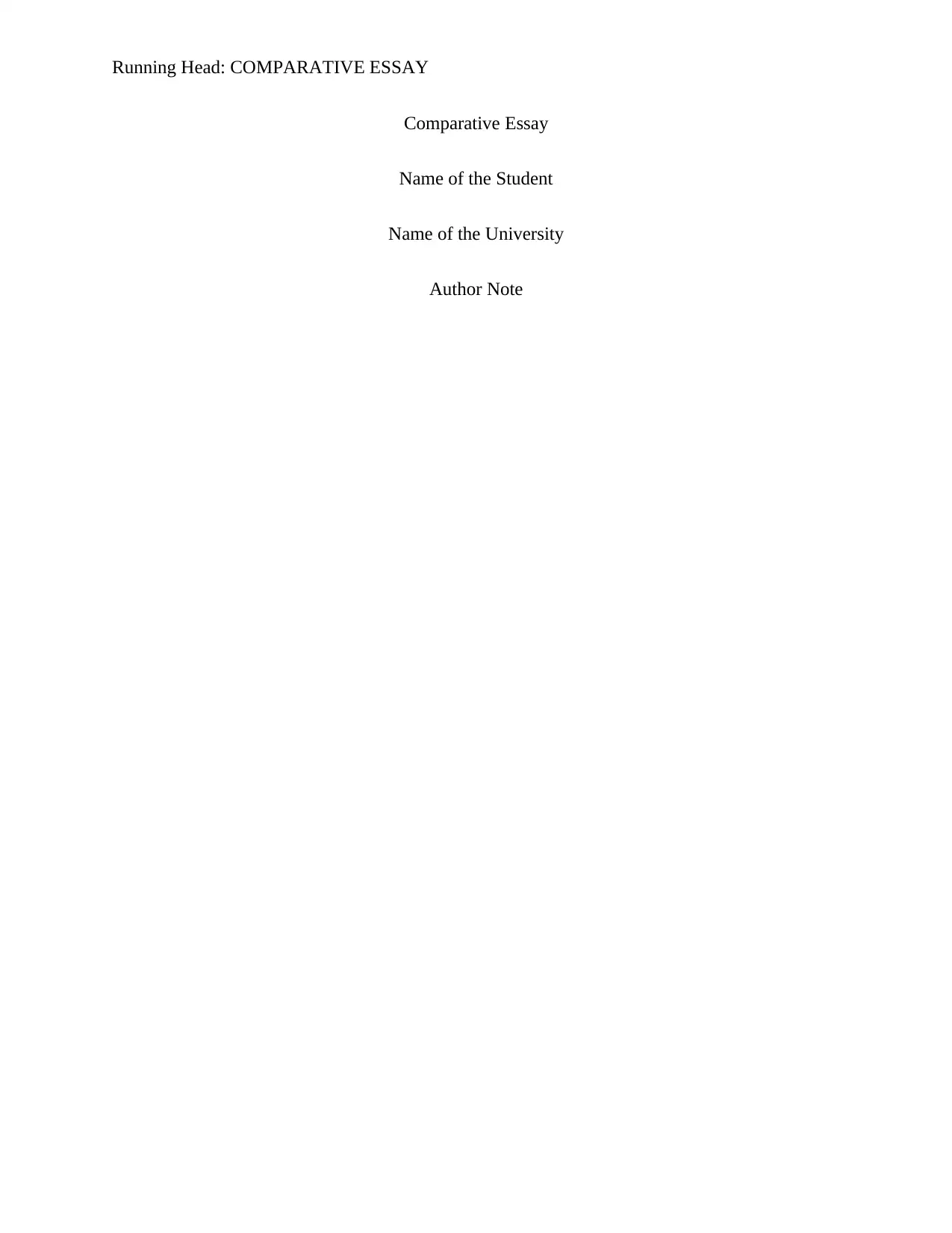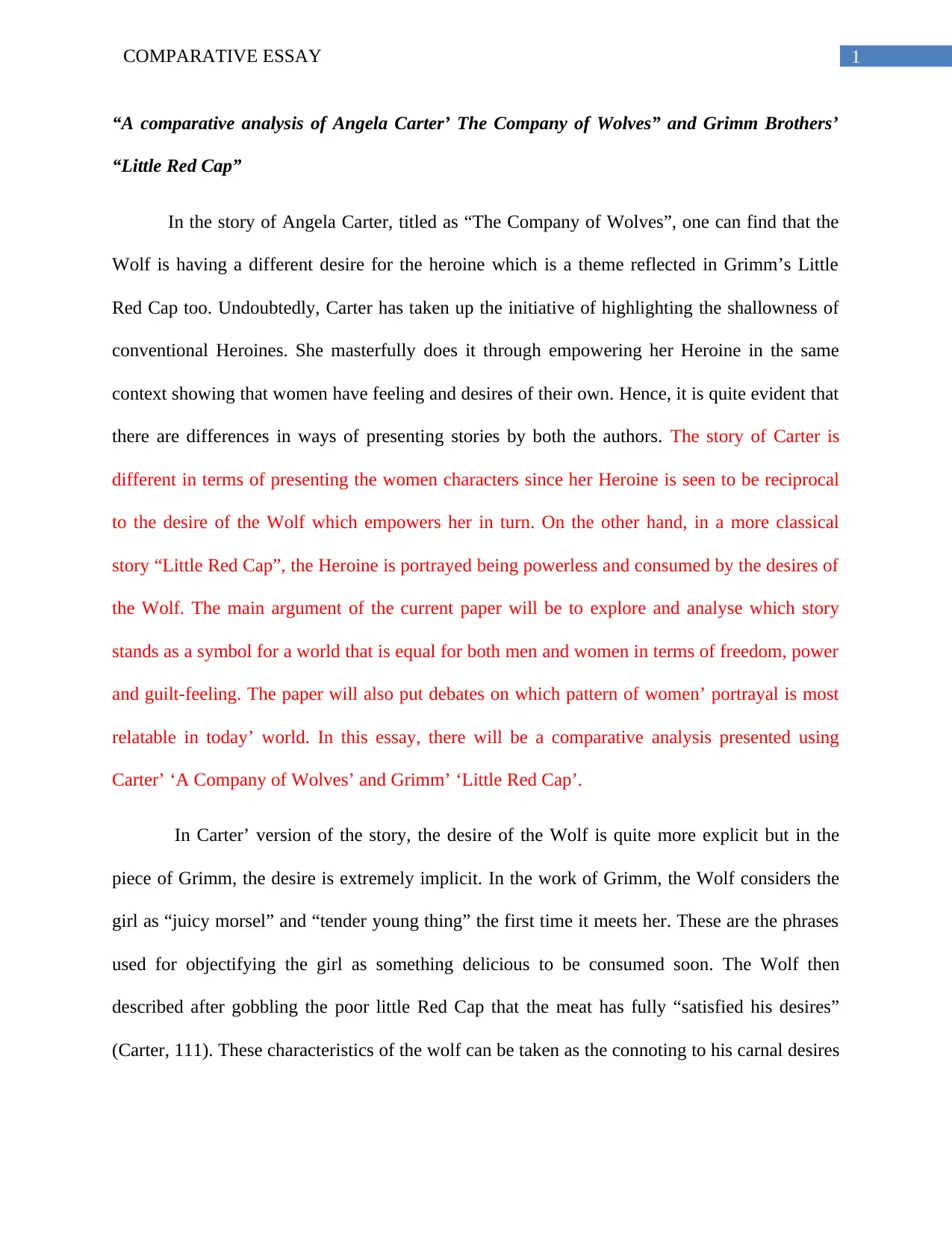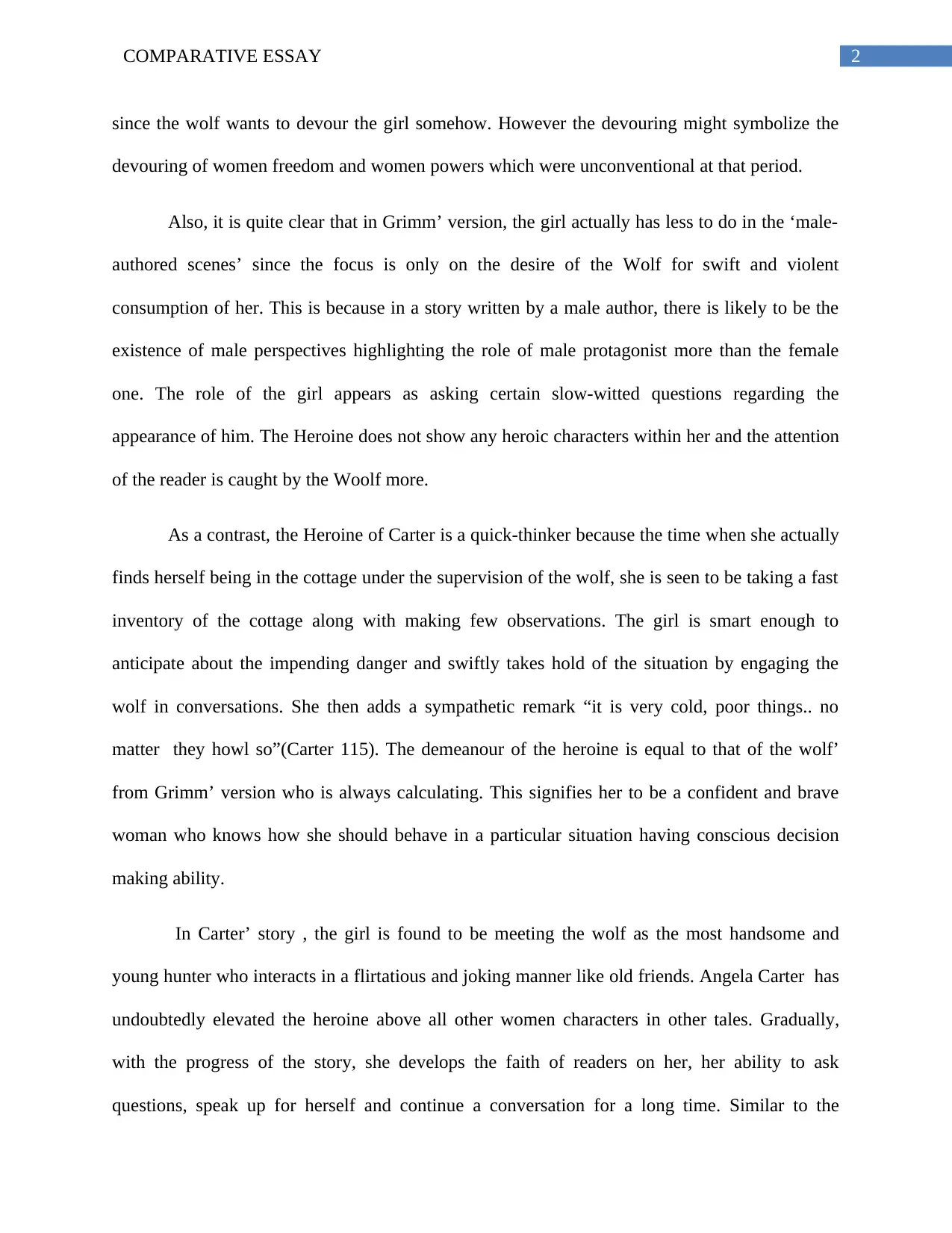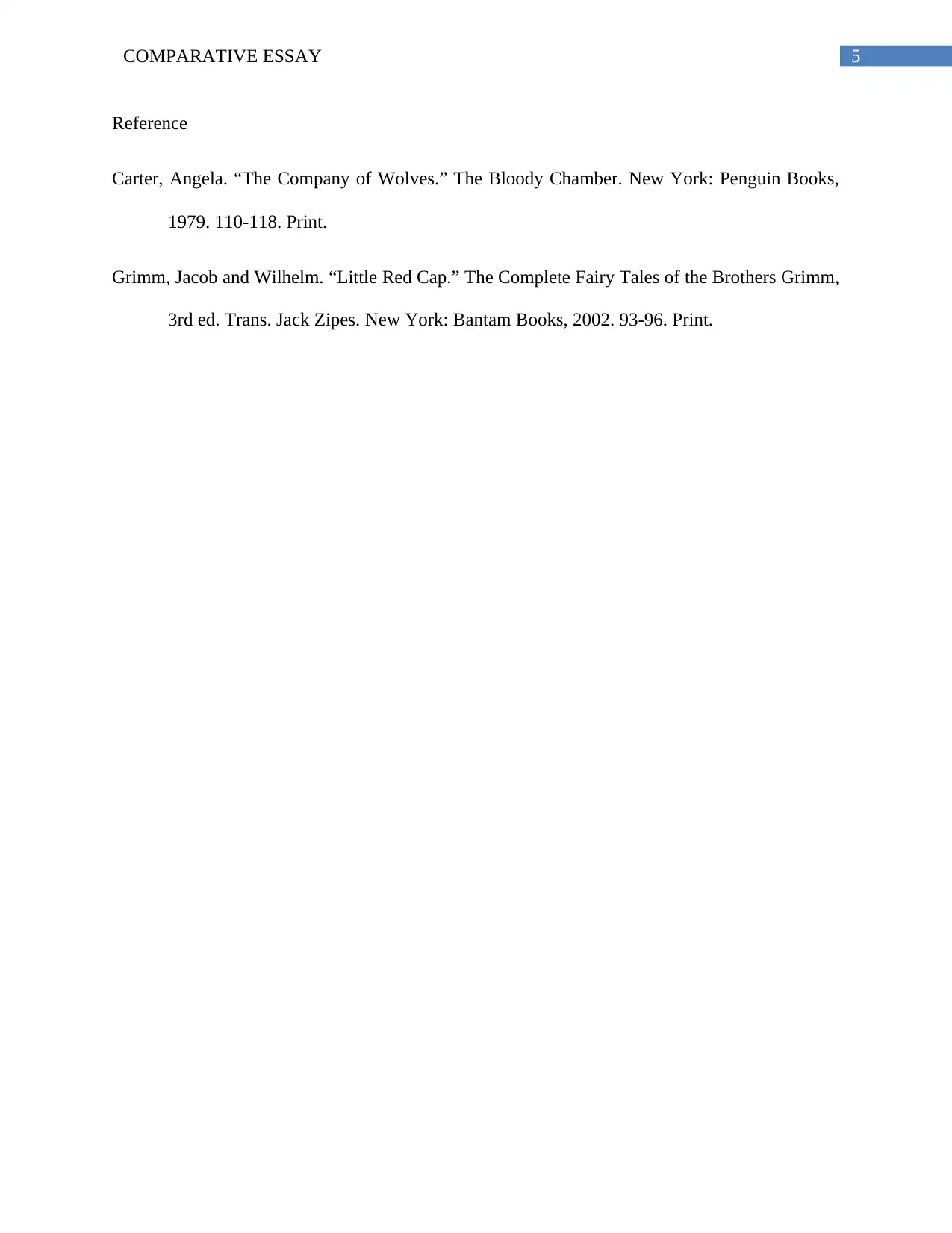Comparative Essay: ENG1120S - Wolves and Red Cap: A Literary Analysis
VerifiedAdded on 2022/08/16
|6
|1487
|12
Essay
AI Summary
This essay presents a comparative analysis of Angela Carter's "The Company of Wolves" and Grimm Brothers' "Little Red Cap," focusing on the contrasting portrayals of women and their roles within the narratives. The essay argues that Carter's version empowers the heroine by giving her agency and control over her destiny, contrasting with Grimm's depiction of a passive and vulnerable female character. The analysis examines the explicit and implicit desires of the wolf figures in each story, highlighting how Carter subverts traditional fairy tale tropes to explore themes of female sexuality, independence, and self-awareness. The essay explores the evolution of the heroine's character, showcasing her confidence, intelligence, and ability to navigate dangerous situations. The conclusion emphasizes that Carter's story offers a more relatable and empowering representation of women in the modern world, where female empowerment is celebrated rather than punished, unlike the traditional portrayal in Grimm's version. The essay uses textual evidence, including direct quotations, to support its claims and provides a detailed comparison of the two stories' narrative structures, characterizations, and thematic concerns.

Running Head: COMPARATIVE ESSAY
Comparative Essay
Name of the Student
Name of the University
Author Note
Comparative Essay
Name of the Student
Name of the University
Author Note
Paraphrase This Document
Need a fresh take? Get an instant paraphrase of this document with our AI Paraphraser

1COMPARATIVE ESSAY
“A comparative analysis of Angela Carter’ The Company of Wolves” and Grimm Brothers’
“Little Red Cap”
In the story of Angela Carter, titled as “The Company of Wolves”, one can find that the
Wolf is having a different desire for the heroine which is a theme reflected in Grimm’s Little
Red Cap too. Undoubtedly, Carter has taken up the initiative of highlighting the shallowness of
conventional Heroines. She masterfully does it through empowering her Heroine in the same
context showing that women have feeling and desires of their own. Hence, it is quite evident that
there are differences in ways of presenting stories by both the authors. The story of Carter is
different in terms of presenting the women characters since her Heroine is seen to be reciprocal
to the desire of the Wolf which empowers her in turn. On the other hand, in a more classical
story “Little Red Cap”, the Heroine is portrayed being powerless and consumed by the desires of
the Wolf. The main argument of the current paper will be to explore and analyse which story
stands as a symbol for a world that is equal for both men and women in terms of freedom, power
and guilt-feeling. The paper will also put debates on which pattern of women’ portrayal is most
relatable in today’ world. In this essay, there will be a comparative analysis presented using
Carter’ ‘A Company of Wolves’ and Grimm’ ‘Little Red Cap’.
In Carter’ version of the story, the desire of the Wolf is quite more explicit but in the
piece of Grimm, the desire is extremely implicit. In the work of Grimm, the Wolf considers the
girl as “juicy morsel” and “tender young thing” the first time it meets her. These are the phrases
used for objectifying the girl as something delicious to be consumed soon. The Wolf then
described after gobbling the poor little Red Cap that the meat has fully “satisfied his desires”
(Carter, 111). These characteristics of the wolf can be taken as the connoting to his carnal desires
“A comparative analysis of Angela Carter’ The Company of Wolves” and Grimm Brothers’
“Little Red Cap”
In the story of Angela Carter, titled as “The Company of Wolves”, one can find that the
Wolf is having a different desire for the heroine which is a theme reflected in Grimm’s Little
Red Cap too. Undoubtedly, Carter has taken up the initiative of highlighting the shallowness of
conventional Heroines. She masterfully does it through empowering her Heroine in the same
context showing that women have feeling and desires of their own. Hence, it is quite evident that
there are differences in ways of presenting stories by both the authors. The story of Carter is
different in terms of presenting the women characters since her Heroine is seen to be reciprocal
to the desire of the Wolf which empowers her in turn. On the other hand, in a more classical
story “Little Red Cap”, the Heroine is portrayed being powerless and consumed by the desires of
the Wolf. The main argument of the current paper will be to explore and analyse which story
stands as a symbol for a world that is equal for both men and women in terms of freedom, power
and guilt-feeling. The paper will also put debates on which pattern of women’ portrayal is most
relatable in today’ world. In this essay, there will be a comparative analysis presented using
Carter’ ‘A Company of Wolves’ and Grimm’ ‘Little Red Cap’.
In Carter’ version of the story, the desire of the Wolf is quite more explicit but in the
piece of Grimm, the desire is extremely implicit. In the work of Grimm, the Wolf considers the
girl as “juicy morsel” and “tender young thing” the first time it meets her. These are the phrases
used for objectifying the girl as something delicious to be consumed soon. The Wolf then
described after gobbling the poor little Red Cap that the meat has fully “satisfied his desires”
(Carter, 111). These characteristics of the wolf can be taken as the connoting to his carnal desires

2COMPARATIVE ESSAY
since the wolf wants to devour the girl somehow. However the devouring might symbolize the
devouring of women freedom and women powers which were unconventional at that period.
Also, it is quite clear that in Grimm’ version, the girl actually has less to do in the ‘male-
authored scenes’ since the focus is only on the desire of the Wolf for swift and violent
consumption of her. This is because in a story written by a male author, there is likely to be the
existence of male perspectives highlighting the role of male protagonist more than the female
one. The role of the girl appears as asking certain slow-witted questions regarding the
appearance of him. The Heroine does not show any heroic characters within her and the attention
of the reader is caught by the Woolf more.
As a contrast, the Heroine of Carter is a quick-thinker because the time when she actually
finds herself being in the cottage under the supervision of the wolf, she is seen to be taking a fast
inventory of the cottage along with making few observations. The girl is smart enough to
anticipate about the impending danger and swiftly takes hold of the situation by engaging the
wolf in conversations. She then adds a sympathetic remark “it is very cold, poor things.. no
matter they howl so”(Carter 115). The demeanour of the heroine is equal to that of the wolf’
from Grimm’ version who is always calculating. This signifies her to be a confident and brave
woman who knows how she should behave in a particular situation having conscious decision
making ability.
In Carter’ story , the girl is found to be meeting the wolf as the most handsome and
young hunter who interacts in a flirtatious and joking manner like old friends. Angela Carter has
undoubtedly elevated the heroine above all other women characters in other tales. Gradually,
with the progress of the story, she develops the faith of readers on her, her ability to ask
questions, speak up for herself and continue a conversation for a long time. Similar to the
since the wolf wants to devour the girl somehow. However the devouring might symbolize the
devouring of women freedom and women powers which were unconventional at that period.
Also, it is quite clear that in Grimm’ version, the girl actually has less to do in the ‘male-
authored scenes’ since the focus is only on the desire of the Wolf for swift and violent
consumption of her. This is because in a story written by a male author, there is likely to be the
existence of male perspectives highlighting the role of male protagonist more than the female
one. The role of the girl appears as asking certain slow-witted questions regarding the
appearance of him. The Heroine does not show any heroic characters within her and the attention
of the reader is caught by the Woolf more.
As a contrast, the Heroine of Carter is a quick-thinker because the time when she actually
finds herself being in the cottage under the supervision of the wolf, she is seen to be taking a fast
inventory of the cottage along with making few observations. The girl is smart enough to
anticipate about the impending danger and swiftly takes hold of the situation by engaging the
wolf in conversations. She then adds a sympathetic remark “it is very cold, poor things.. no
matter they howl so”(Carter 115). The demeanour of the heroine is equal to that of the wolf’
from Grimm’ version who is always calculating. This signifies her to be a confident and brave
woman who knows how she should behave in a particular situation having conscious decision
making ability.
In Carter’ story , the girl is found to be meeting the wolf as the most handsome and
young hunter who interacts in a flirtatious and joking manner like old friends. Angela Carter has
undoubtedly elevated the heroine above all other women characters in other tales. Gradually,
with the progress of the story, she develops the faith of readers on her, her ability to ask
questions, speak up for herself and continue a conversation for a long time. Similar to the
⊘ This is a preview!⊘
Do you want full access?
Subscribe today to unlock all pages.

Trusted by 1+ million students worldwide

3COMPARATIVE ESSAY
traditional wolf that symbolise might and vigour, the young hunter also makes a scheme for
having the girl and the grandmother both. The girl too has a scheme of wining the handsome
gentleman revealing her own desire and the reader then learns her hidden crafty nature too.
The readers are left surprised by Carter’ presentation of heroine who has her own desire
from the starting of the story. A strong-minded girl has been portrayed who is confident, fearless
and clever too. The girl is aware of the desire of the wolf who wants to eat her and transforms
this knowledge into her power over the wolf. The wolf says: “all the better to eat you with”, the
girl is seen as laughing at the wolf having known that “she was nobody’ meat”(Carter, 112). The
reader is made quite sure that the girl also desires the wolf which is different from the ‘gobbling’
in Grimm’ version evident when the girl seduces then wolf turning tables on the wolf..
Hence, on a concluding note, it can be said that through providing the heroine an identity
of her own, Carter is found to be making the girl’ character quite three dimensional who plays a
significant role in the story representing modern independent and confident women unlike that of
Grimm’ vigourless women character. The Heroine of Carter has thoughts of her own, feelings of
her own who is quite able to respond to the desires of the wolf at the end. Hence, it would not be
wrong to say that Angela Carter’ The Company of Wolves is that category of the story where the
women empowerment is celebrated, rewarded rather than being punished that is most relatable in
today’ world. The girl at the end is seen to be embracing all her power and the sexuality making
a memory in the readers’ mind even today.
Reflection
Firstly, the title of the essay has been changed from “The Company of Wolves versus
Little Red Cap : Desire empowers her not devours her” to “A comparative analysis of Angela
traditional wolf that symbolise might and vigour, the young hunter also makes a scheme for
having the girl and the grandmother both. The girl too has a scheme of wining the handsome
gentleman revealing her own desire and the reader then learns her hidden crafty nature too.
The readers are left surprised by Carter’ presentation of heroine who has her own desire
from the starting of the story. A strong-minded girl has been portrayed who is confident, fearless
and clever too. The girl is aware of the desire of the wolf who wants to eat her and transforms
this knowledge into her power over the wolf. The wolf says: “all the better to eat you with”, the
girl is seen as laughing at the wolf having known that “she was nobody’ meat”(Carter, 112). The
reader is made quite sure that the girl also desires the wolf which is different from the ‘gobbling’
in Grimm’ version evident when the girl seduces then wolf turning tables on the wolf..
Hence, on a concluding note, it can be said that through providing the heroine an identity
of her own, Carter is found to be making the girl’ character quite three dimensional who plays a
significant role in the story representing modern independent and confident women unlike that of
Grimm’ vigourless women character. The Heroine of Carter has thoughts of her own, feelings of
her own who is quite able to respond to the desires of the wolf at the end. Hence, it would not be
wrong to say that Angela Carter’ The Company of Wolves is that category of the story where the
women empowerment is celebrated, rewarded rather than being punished that is most relatable in
today’ world. The girl at the end is seen to be embracing all her power and the sexuality making
a memory in the readers’ mind even today.
Reflection
Firstly, the title of the essay has been changed from “The Company of Wolves versus
Little Red Cap : Desire empowers her not devours her” to “A comparative analysis of Angela
Paraphrase This Document
Need a fresh take? Get an instant paraphrase of this document with our AI Paraphraser

4COMPARATIVE ESSAY
Carter’ The Company of Wolves” and Grimm Brothers’ “Little Red Cap”. Then most of the
passive voice has been changed to active voice. The sentence “Carter has undoubtedly elaborated
the shallowness of the conventional heroines through having empowered her heroine in the same
context showing that women have feeling and desires of her own” has been re-phrased as per the
feedback. In the introductory paragraph, the argument has been written clearly relating to one of
the two stories most appropriate in today’ world. Next, the ideas in certain lines have been
explained properly and connected with the purpose of the essay. The explanation of why “Little
Red Cap” has been called a male authored story along with its significance has further been
given. Also, the importance of providing quotations from the text has been given. There are
certain words that have been replaced with more suitable words and few sentences have been re-
phrased as per the requirements. The summary paragraphs have been reduced and some useful
analysis has been put in its place. In the concluding paragraph, the argument has been re-stated
and connected with the contemporary world. It finds Carter’ story and the portrayal of women to
be more linked with the modern society.
Carter’ The Company of Wolves” and Grimm Brothers’ “Little Red Cap”. Then most of the
passive voice has been changed to active voice. The sentence “Carter has undoubtedly elaborated
the shallowness of the conventional heroines through having empowered her heroine in the same
context showing that women have feeling and desires of her own” has been re-phrased as per the
feedback. In the introductory paragraph, the argument has been written clearly relating to one of
the two stories most appropriate in today’ world. Next, the ideas in certain lines have been
explained properly and connected with the purpose of the essay. The explanation of why “Little
Red Cap” has been called a male authored story along with its significance has further been
given. Also, the importance of providing quotations from the text has been given. There are
certain words that have been replaced with more suitable words and few sentences have been re-
phrased as per the requirements. The summary paragraphs have been reduced and some useful
analysis has been put in its place. In the concluding paragraph, the argument has been re-stated
and connected with the contemporary world. It finds Carter’ story and the portrayal of women to
be more linked with the modern society.

5COMPARATIVE ESSAY
Reference
Carter, Angela. “The Company of Wolves.” The Bloody Chamber. New York: Penguin Books,
1979. 110-118. Print.
Grimm, Jacob and Wilhelm. “Little Red Cap.” The Complete Fairy Tales of the Brothers Grimm,
3rd ed. Trans. Jack Zipes. New York: Bantam Books, 2002. 93-96. Print.
Reference
Carter, Angela. “The Company of Wolves.” The Bloody Chamber. New York: Penguin Books,
1979. 110-118. Print.
Grimm, Jacob and Wilhelm. “Little Red Cap.” The Complete Fairy Tales of the Brothers Grimm,
3rd ed. Trans. Jack Zipes. New York: Bantam Books, 2002. 93-96. Print.
⊘ This is a preview!⊘
Do you want full access?
Subscribe today to unlock all pages.

Trusted by 1+ million students worldwide
1 out of 6
Your All-in-One AI-Powered Toolkit for Academic Success.
+13062052269
info@desklib.com
Available 24*7 on WhatsApp / Email
![[object Object]](/_next/static/media/star-bottom.7253800d.svg)
Unlock your academic potential
Copyright © 2020–2025 A2Z Services. All Rights Reserved. Developed and managed by ZUCOL.

